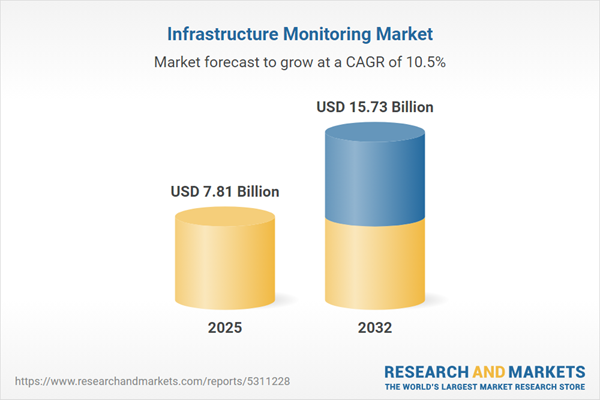Speak directly to the analyst to clarify any post sales queries you may have.
Infrastructure monitoring has become essential for enterprises steering digital transformation and managing mounting regulatory expectations. Senior decision-makers now rely on robust monitoring to uphold operational visibility, adapt to compliance changes, and ensure resilient digital ecosystems that enable ongoing growth.
Market Snapshot: Infrastructure Monitoring Trends and Opportunities
The global infrastructure monitoring market is experiencing dynamic expansion, propelled by extensive adoption of digital initiatives and modernization across IT environments. Organizations now oversee increasingly complex, interconnected systems—including multi-cloud, hybrid, and distributed infrastructures—escalating the need for unified observability. Strategic leaders prioritize platforms designed to drive fiscal efficiency, mitigate business risk, and deliver actionable insights for reliable decision-making. With the landscape turning more interconnected, advanced monitoring solutions position enterprises to stay on top of compliance developments and integrate new technological capabilities for stronger operational transparency. In this climate, infrastructure monitoring underpins business continuity, adaptive response, and enterprise-wide strategic control, marking it as a foundational asset for organizational stability.
Scope & Segmentation of the Infrastructure Monitoring Market
This report breaks down the key segments driving market evolution, providing clarity on emerging technologies, sector requirements, and investment focus. Each area is critical for building strategies that respond to specific operational and regulatory mandates:
- Monitoring Type: Agent-based monitoring delivers granular oversight for mission-critical assets, while agentless tools enable swift deployment and adaptability in constantly evolving IT setups. Both models play a distinct role in tailoring enterprise monitoring protocols.
- Component: Managed services offer integrated solutions for applications, networks, servers, cloud infrastructure, storage, and databases, supporting organizations with comprehensive performance and reliability monitoring across the IT stack.
- Technology: Wired technologies are preferred in highly regulated industries due to their security and control advantages, whereas wireless monitoring extends accessibility to remote locations, distributed teams, and dynamic architectures for greater flexibility.
- End-User Vertical: Aerospace, defense, construction, manufacturing, automotive, oil and gas, and energy industries deploy specialized monitoring to maximize uptime, ensure compliance, and maintain continuous process oversight.
- Geographies: Europe champions sustainable IT innovation, Asia-Pacific leads in analytics-driven progression, and the Middle East, Africa, and the Americas adapt infrastructure monitoring to sector regulations and market conditions.
- Vendors: Established providers such as Cisco Systems, IBM, and Hewlett Packard Enterprise serve a broad spectrum of monitoring requirements, while niche innovators like Grafana Labs and Prometheus target unique sector-specific challenges.
Key Takeaways: Strategic Insights for Infrastructure Monitoring
- Unified observability platforms offer comprehensive oversight, allowing quick adaptation to business or technology shifts and supporting organizational agility.
- AI and machine learning enhance predictive monitoring, enabling faster identification of disruptions and improved resource planning to protect business continuity.
- Monitoring focused on compliance streamlines process adaptation to new regulations, ensuring ongoing operational resilience while reducing enterprise risk exposure.
- Tailored solutions in high-stakes sectors enhance process control, supporting industry-specific demands and maintaining stable, compliant operations.
- Monitoring strategies aligned with digital transformation break down silos, advancing interoperability and fostering unified enterprise oversight.
- Regional investments are often shaped by drivers such as sustainability in Europe, analytics acceleration in Asia-Pacific, and sector-led compliance in the Americas.
Tariff Impact on Infrastructure Monitoring Supply Chains
Recent tariff changes in the United States have driven up hardware costs and introduced additional complexity to the infrastructure monitoring supply chain. In response, organizations are evaluating deployment models, increasingly turning toward managed services and cloud-based solutions. These shifts aim to enhance supply chain transparency, reduce risk, and bolster operational continuity amid evolving regulatory and market landscapes.
Methodology & Data Sources
This analysis is based on expert interviews alongside comprehensive quantitative survey results, validated by triangulating findings with multiple trusted sources. Insights are further assessed for their direct relevance to procurement, IT leadership, and executive strategy in enterprise environments.
Why This Report Matters
- Supports senior leadership in optimizing IT investments and selecting the most suitable vendors, especially for industries facing continuous regulatory changes and fast technology evolution.
- Presents actionable recommendations aligning transformation strategies with compliance requirements, risk management, and enterprise resilience for robust executive decision-making.
- Streamlines the evaluation and benchmarking of infrastructure monitoring platforms, reinforcing oversight and adaptability within varied regulatory and operational settings.
Conclusion
Effective infrastructure monitoring is vital for operational resilience and strategic advancement in digital-driven enterprises. This report arms decision-makers with the insights they need to guide change, uphold business continuity, and manage compliance in modern IT environments.
Additional Product Information:
- Purchase of this report includes 1 year online access with quarterly updates.
- This report can be updated on request. Please contact our Customer Experience team using the Ask a Question widget on our website.
Table of Contents
3. Executive Summary
4. Market Overview
7. Cumulative Impact of Artificial Intelligence 2025
Companies Mentioned
The companies profiled in this Infrastructure Monitoring market report include:- Auvik Networks Inc.
- BMC Software, Inc.
- Broadcom, Inc.
- Cisco Systems, Inc.
- Datadog
- Dynatrace Inc.
- eG Innovations
- Grafana Labs
- Hewlett Packard Enterprise Company
- Icinga GmbH
- International Business Machines Corporation
- Kentik, Inc.
- LogicMonitor Inc.
- Microsoft Corporation
- Nagios Enterprises, LLC
- NEW RELIC INC.
- Opsview Ltd.
- Paessler GmbH
- Progress Software Corporation
- Prometheus by The Linux Foundation
- ScienceLogic, Inc.
- SolarWinds Worldwide, LLC
- Splunk LLC
- Sumo Logic, Inc.
- Zabbix LLC
- Zoho Corporation Pvt. Ltd.
Table Information
| Report Attribute | Details |
|---|---|
| No. of Pages | 197 |
| Published | November 2025 |
| Forecast Period | 2025 - 2032 |
| Estimated Market Value ( USD | $ 7.81 Billion |
| Forecasted Market Value ( USD | $ 15.73 Billion |
| Compound Annual Growth Rate | 10.4% |
| Regions Covered | Global |
| No. of Companies Mentioned | 27 |









